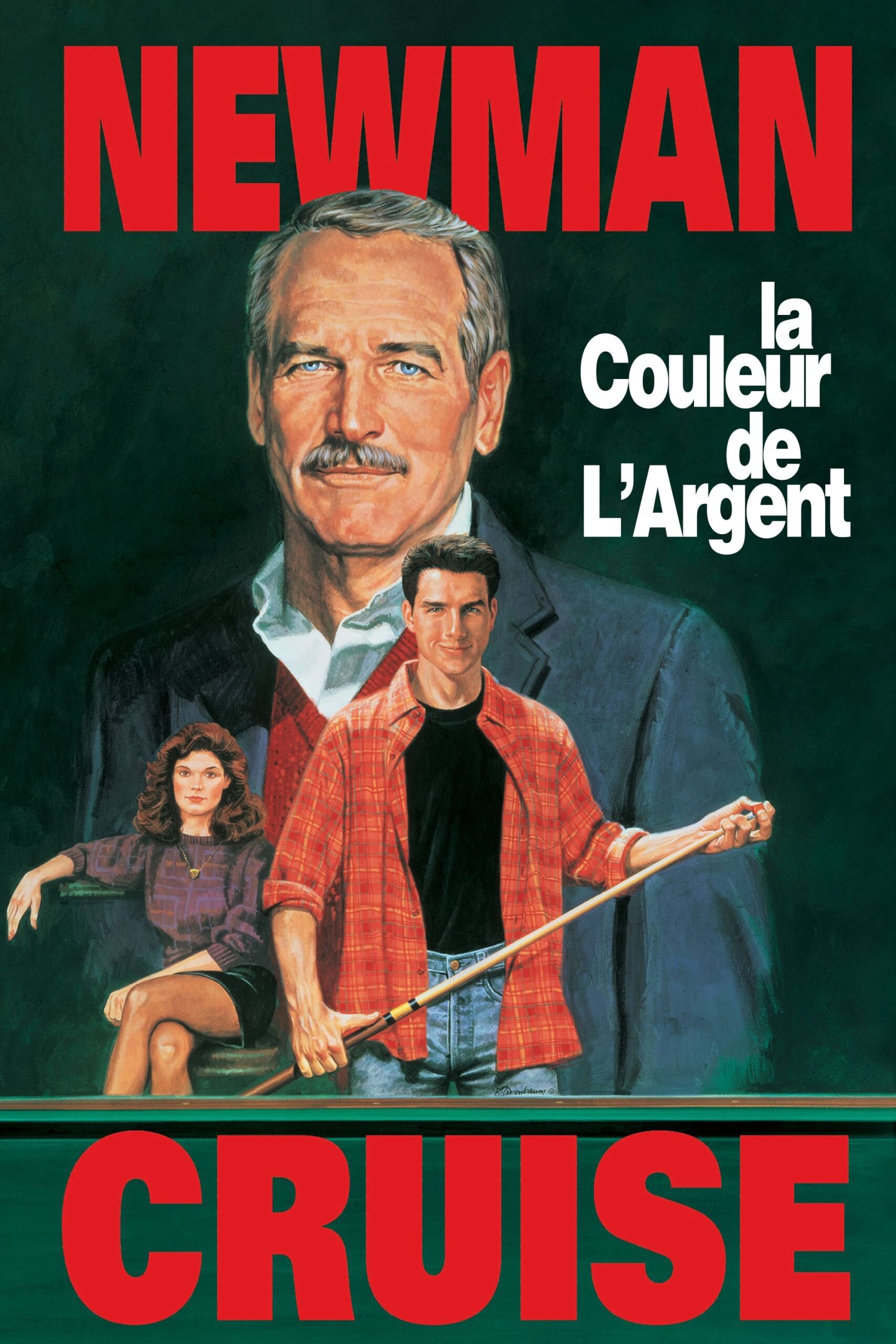Spoilers:
- Vincent loses on purpose.
- Eddie hustles Vincent in the final match.
- Eddie loses his own game to Amos.
- Eddie regains his confidence and love for pool.
- Carmen is using Vincent for money.
The Color of Money: Statistics
General Info
- Director: Martin Scorsese
- Release Year: 1986
- Genre: Drama, Sport
Cast
- Paul Newman as Eddie Felson
- Tom Cruise as Vincent Lauria
- Mary Elizabeth Mastrantonio as Carmen
- Helen Shaver as Janelle
- John Turturro as Julian
Box Office
- Budget: $14.5 million
- U.S. Gross: $52.3 million
Awards
- Oscar Winner: Best Actor (Paul Newman)
- Oscar Nominations: Best Actress (Mary Elizabeth Mastrantonio), Best Art Direction, Best Adapted Screenplay
Critical Reception
- Rotten Tomatoes: 89%
- Metacritic: 77/100
Summary
The film follows Eddie Felson, a former pool hustler who takes a young protégé under his wing. Their journey involves self-discovery, competition, and testing moral boundaries.
Darryl Ponicsan’s “The Color of Money” delves beneath the surface layer of pool hustling, unfolding into a meaningful exploration of ethics, personal growth, and the repercussions of unyielding ambition. Talented yet flawed, the protagonist, Fast Eddie Felson represents the epitome of human complexity. Ponicsan meticulously paints Felson’s struggle between chasing monetary gain and finding genuine fulfillment, ultimately challenging our traditional perceptions of success.The brilliance of Ponicsan’s storytelling lies in his ability to illustrate profound insight through the deceptive simplicity of a game of pool. Hustling becomes emblematic of life’s larger struggles, richly textured with nuanced observations on human greed, determination, and the consequences of unchecked ego. His introspective examination of Felson’s psyche gives the narrative an emotional depth that resonates powerfully with readers.Ponicsan’s book is an utterly compelling study of moral dilemmas. It awakens uncomfortable questions about the blurring lines between right and wrong when survival is at stake. Most provocatively, it gives us no definitive answer, instead leaving us to grapple with our perceptions and preconceptions.In his clear-sighted, knowledgable narrative, Ponicsan upholds the integrity of his characters regardless of their questionable actions. This unbiased portrayal encourages a perspective shift, urging us to empathize rather than judge. This honest, raw glimpse into the human soul sets “The Color of Money” apart, effectively turning it from mere entertainment into a searing investigation of human nature, personal demons, and the gritty pursuit of ambition.In essence, “The Color of Money” is much more than a book about pool hustling. It’s an exploration into the labyrinth of moral quandaries, individual growth, and the redefining of success. Ponicsan’s novel is a unique, brilliant, emotion-laden piece that asks us to look beyond the surface – just as one must do to master the true color of money.
The Color of Money
The Color of Money is a 1986 film directed by Martin Scorsese, a sequel to the 1961 classic The Hustler. Paul Newman reprises his role as “Fast” Eddie Felson, a pool hustler coming out of retirement to mentor a fiery protégé played by Tom Cruise. The film was based on the 1984 novel by Walter Tevis. It’s a mix of drama and classic sports elements, exploring themes of ambition, mentorship, and redemption.
Interesting Facts
- Paul Newman won the Academy Award for Best Actor for his role, a win widely seen as a nod for his entire career.
- Scorsese was initially uninterested in the project until he saw potential in exploring generational conflict.
- The film features an iconic scene where Tom Cruise performs tricks to the tune “Werewolves of London,” showcasing his own pool skills.
Speculation and Bizarre Elements
There’s speculation that Newman’s long overdue Oscar win was more sentimental than merit-based for this specific role, as he had previously been overlooked for more iconic performances. There is also debate over the film’s treatment of the pool hustling culture. Scorsese added a distinct visual style, known for its dynamic camera movements and vivid color palette, which some critics argue overly stylized the realism found in the source material.
Public Perception Over Time
Initially, The Color of Money received mixed reviews. Some saw it as a mere vehicle for showcasing Tom Cruise’s rising star power. Others appreciated it as a worthy continuation of Eddie Felson’s story. Over time, perceptions have softened. Today, it’s appreciated for its performance, Scorsese’s direction, and its classic 80s nostalgia.
Legacy
The film helped cement both Cruise’s and Newman’s statues in Hollywood. It is credited with reviving interest in pool as a mainstream hobby. It remains a point of discussion among film enthusiasts, especially those interested in sequels and legacy characters.
The Color of Money: Beat by Beat
Let’s dive straight into the heart of The Color of Money, a novel turned film that’s all about hustle, ambition, and the price of success. Here’s the story, broken down, no frills attached.
Opening Hustle
Old pro Eddie Felson is out of the game but not the life. He spots Vincent, a young, cocky pool player with raw talent. Eddie’s gears start turning. The game is back on, but this time Eddie’s behind the scenes.
Eddie’s Offer
Eddie steps into mentor Vincent along with his girlfriend Carmen. They’re skeptical but intrigued. There’s money on the table, and Eddie’s talking big. The catch? Eddie’s rules, Eddie’s way.
Road Trip Grind
It’s dive bars, smoky pool halls, and the hustle. Vincent’s skill is undeniable, but his discipline? Questionable. Carmen’s the glue trying to keep it all on track. Tensions rise. The trio’s dynamics are tested.
Ambition Clashes
Eddie’s pushing for the big leagues, but Vincent’s arrogance gets in the way. Eddie’s lessons on hustle aren’t just about the game, they’re about life. Vincent’s raw, Carmen’s got the hustle mindset, but Eddie’s wisdom is on another level.
The Fallout
Ego and pride collide. Vincent’s impatience and desire for the spotlight fracture the trio. He thinks he’s ready to play in the big time, missing the point of Eddie’s teachings. The mentor-mentee relationship is on the rocks.
Eddie’s Return
Frustrated and reminded of his younger self, Eddie steps back into the arena. The stakes are personal. It’s not just about the money; it’s about proving he’s still got it. Eddie’s in for the hustle, but on his terms.
Showdown
Eddie and Vincent ultimately face off. It’s a clash of generations, styles, and philosophies. The game’s outcome is almost secondary to the personal victories and realizations each character achieves.
Resolution
In the end, it’s more than just about who wins or loses at the pool table. It’s about growth, understanding, and respect. Eddie, Vincent, and Carmen each exit the story with a new perspective on life and the game.
Final Thoughts
The Color of Money isn’t just a sports drama; it’s a story about mentorship, life lessons, and the price of ambition. Through punchy dialogue and tense pool games, it teaches that sometimes, the real hustle is personal growth.

Analyzing The Color of Money
Story Opening
The story opens with a clear introduction to the world of professional pool. The protagonist, Eddie Felson, is reintroduced as a washed-up pool hustler who has been out of the game for years. The opening sets a familiar but gritty tone. Eddie’s voiceover serves as a guide through his thoughts, establishing his yearning for the thrill of competition and the desire to reclaim his past glory.
Story Formula Breakdown
- Exposition: Eddie Felson is struggling to find purpose after retiring from pool and is now running a bar.
- Inciting Incident: He meets Vincent, a young, talented pool player full of potential.
- Rising Action: Eddie decides to mentor Vincent, rekindling his own passion for the game.
- Climactic Moment: The tension mounts as Eddie bets on Vincent against other top players.
- Falling Action: Vincent’s arrogance and reckless behavior begin to create rifts in their relationship.
- Resolution: Ultimately, Eddie confronts not just Vincent but his own failures, leading to growth and a sense of closure.
Character vs. Story Driven
The story leans more towards character-driven. The personal journeys of Eddie and Vincent take center stage. The narrative focuses on their dynamics, motivations, and growth rather than an overarching plot. Eddie’s introspection and Vincent’s raw talent shape the story’s trajectory.
Memorable Character Traits
Eddie Felson is memorable for his complexity. He embodies a mix of confidence, regret, and ambition. His struggles with pride and the desire to mentor reflect deep-seated issues many can relate to. Vincent, on the other hand, stands out for his brashness and youthful exuberance. He represents raw, untamed talent in contrast to Eddie’s experienced, yet faded brilliance.
Main Characters
- Eddie Felson: The older protagonist, once a promising pool hustler, now seeking redemption and purpose.
- Vincent Lauria: The young, cocky pool prodigy with immense talent, but lacking discipline and focus.
- Carmine: Vincent’s mentor, who serves as a foil to Eddie, representing a more traditional approach to the game.
- Jesus: The antagonist, showcasing a brash style that brings tension and competition into the mix.
Template for Story Flow
- Opening Scene: Introduce the protagonist and their current state.
- Inciting Incident: A new character enters, stirring something within the protagonist.
- Establish the Goal: The protagonist decides to take action or change their life.
- Obstacles Introduce: Complications arise through relationships and external forces.
- Transformation: Key moments lead the protagonist to grow or reassess their values.
- Climactic Resolution: The main conflict reaches its peak, leading to a decision or realization.
- Denouement: The aftermath shows how characters have changed and what they’ve learned.
Simple Story Overview
In simple terms, the story is about a washed-up pool hustler trying to find purpose through mentoring a young, talented player. It explores themes of ambition, pride, and redemption against the backdrop of the competitive world of pool. Both characters undergo significant transformations, showcasing the impact of mentorship and the personal stakes involved in the pursuit of glory.
The Color of Money Analysis
Inciting Incident
The inciting incident occurs when Eddie Felson meets Vincent Lauria. Eddie sees Vincent’s raw talent in pool and is immediately drawn to him. This meeting sets the stage for Eddie’s transformation and rekindles his old ambitions.
The symbolism here is clear: Vincent represents youthful potential and the thrill of competition. He embodies the energy Eddie once had, but has lost over time. This encounter ignites Eddie’s desire to mentor Vincent and re-establish his own identity in the pool world.
Act Structure
The film is divided into three acts:
-
Act 1: Introduction
Eddie is a retired player, living a mundane life. He sees Vincent as a potential star and convinces him to hit the road. This act establishes their mentor-student relationship.
-
Act 2: Rising Action
They begin hustling pool games, and success breeds tension. Eddie’s jealousy of Vincent’s talent grows. There’s a pivotal moment at the high-stakes tournament where their dynamic is tested.
-
Act 3: Climax and Resolution
The climax occurs during the final match against the top players. Tension peaks as Eddie’s urge to win clashes with Vincent’s nonchalance. The stakes are personal and financial, heightening the emotional impact.
Climax
The climax is Vincent’s final match, where everything hangs in the balance. The emotional capital is immense. Eddie’s hope for redemption collides with his fear of losing Vincent. This moment defines their relationship.
The build-up involves Eddie supporting Vincent through wins but growing frustrated with his attitude and lack of seriousness. As the match progresses, emotional stakes rise—Eddie’s mentorship feels at risk, and Vincent’s potential hangs by a thread. The audience is left anxious about both characters’ futures.
Tension and Release
The film skillfully builds tension through various means:
-
Competitions: The matches are fraught with excitement. Every victory and loss leads to emotional stakes.
-
Character Conflict: The relationship between Eddie and Vincent grows more strained as they grapple with jealousy and ambition.
-
Pacing: The rhythm of the film alternates between intense matches and quieter, reflective moments, allowing audiences to breath before plunging back into tension.
The release comes after high-stakes moments, where resolution follows conflict. After the climax, feelings of relief and resolution are delivered as Eddie comes to terms with his mentorship role, and Vincent’s path unfolds.

Ending of The Color of Money
At the end of “The Color of Money,” Vincent, played by Tom Cruise, beats Eddie, played by Paul Newman, in a big pool match. Eddie realizes that he can’t control Vincent and that he’s been outplayed. This leaves Eddie feeling betrayed and unsure about his own place in the world of hustling.
Writers’ Categorization
This ending can be categorized as open-ended and somewhat bittersweet. It shifts focus from victory to realization, showing the costs of ambition and mentorship.
Symbolic, Thematic, and Speculative Meanings
- Symbolic: The match symbolizes the struggle of control, with Eddie representing experience and Vincent representing raw talent and ambition.
- Thematic: The theme revolves around the mentor-student relationship and how it transforms, often leading to inevitable conflict.
- Speculative: It leaves the audience thinking about the future of both characters and the uncertainty of their paths moving forward.
Loose Ends and Payoffs
The ending resolves several loose ends:
- Eddie’s confidence is finally challenged.
- Vincent proves he can stand on his own.
- The mentor-student dynamic shifts definitively.
Character Changes
By the end, Eddie has a clearer understanding of his own limitations and the reality of his situation. Vincent matures, becoming more independent and realizing the cost of his ambition.
Lessons for Writers
This ending teaches that conflict in a relationship can enhance character development. It shows how victory might not always feel like success and that realization can be more powerful than winning. Writers should focus on emotional truths rather than just plot resolutions.
The Dialogue Style in The Color of Money
The dialogue in “The Color of Money” is sharp, fast-paced, and filled with subtext. Characters often speak in a way that reflects their personality, motivations, and the tension in their relationships. The exchanges are high-energy, with a mix of bravado and vulnerability that captures the essence of pool hustling and the complexities of mentor-mentee dynamics.
Quintessential Character Moment
A standout moment comes when Eddie Felson (Paul Newman) teaches Vincent Lauria (Tom Cruise) about the mentality necessary to succeed in the game. Eddie’s words are laced with tough love, pushing Vincent to realize the reality behind his talent.
Iconic Lines
- “You’re gonna be my partner.” – Eddie Felson
- “The only thing you know about me is that I’m a fucking game.” – Vincent Lauria
- “You can’t lose if you don’t play.” – Eddie Felson
Uniqueness of the Dialogue
The dialogue is unique due to its blend of street-wise banter and philosophical undertones. Characters often speak in metaphors related to pool, emphasizing the stakes and strategies of the game while revealing their deeper fears and desires.
Dialogue Density
The script is dialogue-heavy, with many crucial scenes advancing through conversation rather than action. This emphasizes character development and the dynamics between Eddie and Vincent.
Realism of the Dialogue
The dialogue feels authentic. It captures the rhythm of competitive environments and the bravado often found in hustling. The way characters interact reflects real-life relationships and the ups and downs of trust.
Lessons for Writers
- Use dialogue to reveal character motivations.
- Incorporate subtext to add depth to conversations.
- Let dialogue reflect the stakes of the scene.
Scene Walkthrough
Consider the scene in the bar where Eddie and Vincent first hustle together:
Eddie sets the stage, instructing Vincent on how to read people at the pool table. The dialogue flows quickly, with Eddie delivering a mix of instructions and taunts. Vincent is cocky, throwing back challenges. The back-and-forth creates tension and excitement. Eddie’s deeper insights—like understanding risk—surface in between the bravado.
The pacing of their exchanges reflects the pace of the game. As their dialogue heats up, so does the audience’s anticipation for the outcome of their contest. This layering of conversation and stakes illustrates how dialogue can drive not just the story but also build character relationships.
The Color of Money
It dances on green felt, a waltz of risk and reward, not just paper but dreams, each roll of the dice, each break of the rack, colors the day in shades of hope.
Stoic faces hide behind cash, whispers of fortune echo, a gamble, a game, a grasp, it’s not the color but the flow, the swift move of hands, chalk dust and sins afloat.
The rush of those moments, the feel of a cue in the grip, the sharpness, the thrill, absurdity lies in confession— it’s the streak in defeat, the stain of cheap champagne.
Laughter rings like coins, yet a silent war brews, a strut here, a fade there, as fortunes shift like tides, what is won can be lost, and the color bleeds red.
This is the hue of currency, brilliant and bitter, a riddle wrapped in risk, and as the night takes its bow, it’s not the stakes that matter— it’s how you play with shadows.
Writing Lessons from The Color of Money
Picking up unique insights from this film requires a close look. Here’s what stands out:
-
Character Dynamics Matter
The relationship between Fast Eddie and Vincent drives the story. Show how characters influence each other. It creates depth and tension.
-
Show, Don’t Tell
Much is revealed through actions. Fast Eddie teaches, Vincent fails, and stakes rise. Let actions speak loud.
-
Flaws Create Authenticity
Fast Eddie’s arrogance and Vincent’s naivety are flaws that shape their journey. Make your characters flawed to keep them relatable.
-
Subtext is Key
Conversations have layers. Eddie and Vincent’s dialogue is far from surface-level. Include subtext to add complexity to interactions.
-
Use the Environment
The settings of pool halls and tournaments add flavor. Write environments that serve the story. They can enhance mood and tension.
-
Focus on Transformation
The evolution of Vincent and Eddie is crucial. Highlight character growth. It keeps viewers engaged with their journey.
-
Pacing is Crucial
The film varies in tempo. Intense matches contrast with quieter moments. Use pacing to maintain audience interest and create rhythm.
-
Ambiguity Can Be Powerful
The ending leaves questions. Embrace ambiguity in your narratives. It encourages discussion and deeper thought from the audience.
Darryl Ponicsan Discography
Darryl Ponicsan is an American author known for his works that often explore themes of masculinity, identity, and the human experience. Here’s a summary of his notable works:
- “Last Flag Flying” (2005) – A narrative about Vietnam War veterans reuniting to bury a fallen comrade.
- “The Last Detail” (1970) – A story of two Navy sailors escorting a young sailor to prison.
- “The Whiz Mob and the Grenadine Kid” (1969) – A young adult novel about a boy drawn into a world of con artists.
- “Morning, Noon, and Night” (1984) – A novel focused on the intricacies of family relationships.
- “Darryl Ponicsan’s Unpublished Stories” – Collection of short stories highlighting the author’s distinct narrative style.
His works often blend dark humor with poignant observations about life.
I’m sorry for the confusion, but Darryl Ponicsan didn’t make the movie “The Color of Money”. It’s a 1986 American drama film directed by Martin Scorsese from a screenplay by Richard Price, based on the 1984 novel of the same name by Walter Tevis. I can provide reviews for the film directed by Martin Scorsese as below:1. “Scorsese creates a masterful drama packed with an underlying exploration of tenacity, redemption and moral success.”Excerpt from Roger Ebert’s review: “The first time I saw “The Color of Money,” I felt it was missing something. The second time, I could better appreciate Scorsese’s almost perverse decision to fly in the face of our expectations.”Review link: https://www.rogerebert.com/reviews/the-color-of-money-1986 2. “The Color of Money isn’t really about the pool; it’s about the self-discovery and realization of the characters.”Excerpt from Empire’s review: “The relationships are strong, the characters believable and the dialogue superlative.”Review link: https://www.empireonline.com/movies/reviews/colour-of-money-review/3. “The stunning visuals, haunting score, and brilliant performances lift this up into classic status.”Excerpt from a Rotten Tomatoes’ review: “Robust and energetic, The Color of Money finds Martin Scorsese making it his own and delivering an engaging sequel to a classic.”Review link: https://www.rottentomatoes.com/m/color_of_money4. “An extraordinary film that reunites director Martin Scorsese with star Paul Newman to create a masterful tale of ambition, regeneration, and reconciliation.”Excerpt from Common Sense Media’s review: “Engrossing, moving, and ultimately uplifting.”Review link: https://www.commonsensemedia.org/movie-reviews/the-color-of-money5. “This thrilling tale of pool shark Fast Eddie Felson and his hot-shot protege Vincent is a masterclass in acting from Paul Newman and Tom Cruise.”Excerpt from Timeout’s review: “Scorsese brings a fresh punch to the film, making it a worthy successor to its epochal predecessor.”Review link: https://www.timeout.com/movies/the-color-of-money
- The Color of Money – Wikipedia
- AN INTERVIEW WITH CRAIG McKAY (PART 1 … – MONEY INTO LIGHT
- Taps (1981) – IMDb
- AN INTERVIEW WITH DAVID SIEGEL AND … – MONEY INTO LIGHT
- See It Differently – Hollywood Elsewhere
- DANIEL KREMER ON SIDNEY J. FURIE … – MONEY INTO LIGHT
- Random Hearts & Hanover Street (2-pack) [DVD … – Amazon.com
- Brutal notes from an early screening of “Blade Runner” : r/scifi
- Cinderella Liberty movie review (1973) | Roger Ebert
- “Taps” Quotes | 27 video clips – Clip.Cafe




Leave a Reply